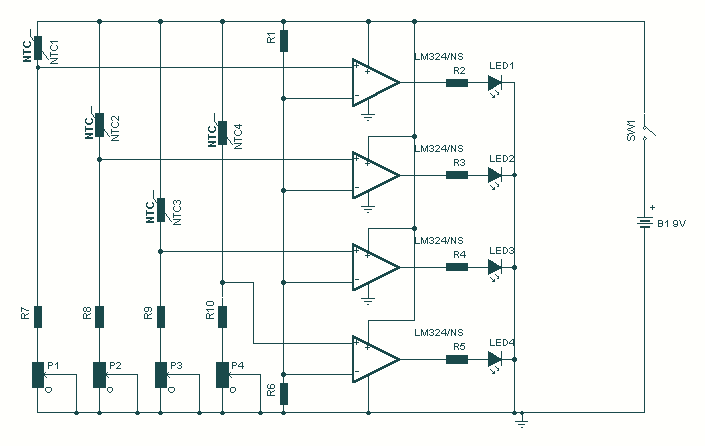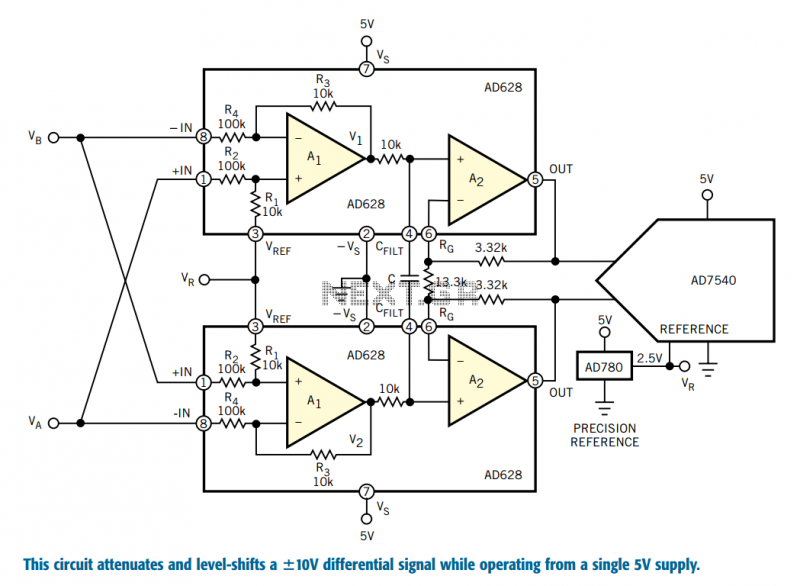
Hot Water Level Indicator

Save fuel bills and the economy of the planet with this circuit. SW1 is a normally open press button switch which allows you to view the level of hot water in a hot water tank. When pressed the voltage difference at the junction of the thermistor and preset is compared to the fixed voltage on the op-amp's non-inverting input. Depending on the heat of the water in the tank, the thermistor's resistance will toggle the op-amp output to swing to almost full voltage supply and light the appropriate LED.
The described circuit serves as a hot water level indicator that utilizes a thermistor to monitor the temperature of the water in a hot water tank. The circuit is initiated by pressing a normally open push button switch, SW1, which activates the measurement process.
In this configuration, the thermistor is connected in a voltage divider arrangement with a preset resistor. The resistance of the thermistor varies inversely with temperature; as the temperature of the water increases, the resistance decreases. This change in resistance alters the voltage at the junction of the thermistor and the preset resistor.
The op-amp used in the circuit is configured as a comparator. The non-inverting input of the op-amp receives a fixed reference voltage, while the inverting input receives the variable voltage from the thermistor-preset divider. When the water temperature rises above a certain threshold, the voltage at the inverting input will exceed the reference voltage at the non-inverting input. This condition causes the op-amp output to switch to a high state, approaching the supply voltage.
The output of the op-amp is connected to a light-emitting diode (LED), which serves as an indicator of the water temperature status. When the op-amp output is high, the LED lights up, providing a visual indication that the water temperature is above the set threshold. This functionality not only helps in monitoring the hot water level but also contributes to energy savings by enabling users to avoid unnecessary heating when the water is already hot.
Overall, this circuit design is efficient and straightforward, making it suitable for applications where monitoring water temperature is essential for energy conservation and operational efficiency.Save fuel bills and the economy of the planet with this circuit. SW1 is a normally open press button switch which allows you to view the level of hot water in a hot water tank. When pressed the voltage difference at the junction of the thermistor and preset is compared to the fixed voltage on the op-amps non-inverting input.
Depending on the heat of the water in the tank, the thermistors resistance will toggle the op-amp output to swing to almost full voltage supply and light the appropriate LED. 🔗 External reference
The described circuit serves as a hot water level indicator that utilizes a thermistor to monitor the temperature of the water in a hot water tank. The circuit is initiated by pressing a normally open push button switch, SW1, which activates the measurement process.
In this configuration, the thermistor is connected in a voltage divider arrangement with a preset resistor. The resistance of the thermistor varies inversely with temperature; as the temperature of the water increases, the resistance decreases. This change in resistance alters the voltage at the junction of the thermistor and the preset resistor.
The op-amp used in the circuit is configured as a comparator. The non-inverting input of the op-amp receives a fixed reference voltage, while the inverting input receives the variable voltage from the thermistor-preset divider. When the water temperature rises above a certain threshold, the voltage at the inverting input will exceed the reference voltage at the non-inverting input. This condition causes the op-amp output to switch to a high state, approaching the supply voltage.
The output of the op-amp is connected to a light-emitting diode (LED), which serves as an indicator of the water temperature status. When the op-amp output is high, the LED lights up, providing a visual indication that the water temperature is above the set threshold. This functionality not only helps in monitoring the hot water level but also contributes to energy savings by enabling users to avoid unnecessary heating when the water is already hot.
Overall, this circuit design is efficient and straightforward, making it suitable for applications where monitoring water temperature is essential for energy conservation and operational efficiency.Save fuel bills and the economy of the planet with this circuit. SW1 is a normally open press button switch which allows you to view the level of hot water in a hot water tank. When pressed the voltage difference at the junction of the thermistor and preset is compared to the fixed voltage on the op-amps non-inverting input.
Depending on the heat of the water in the tank, the thermistors resistance will toggle the op-amp output to swing to almost full voltage supply and light the appropriate LED. 🔗 External reference





